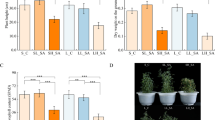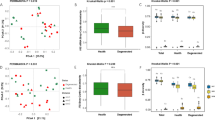Abstract
Pinus heldreichii H. Christ. is a tertiary relict and endemic to the western Balkans and southern part of Apennine peninsula. It is an Oro-Mediterranean species occurring at altitudes between 1200 and 2000 m and primarily on calcareous soils. P. heldreichii forests are of key importance for nature conservation, protection against gravitational natural hazards, landscape conservation and recreation. However, these forests are currently highly fragmented and require the elaboration of guidelines for sustainable management and conservation that should be based on scientific knowledge. Ectomycorrhizal (ECM) fungi are important for successful regeneration, establishment and growth of P. heldreichii. The aim of this study was to investigate ECM and other fungal communities associated with fine roots of P. heldreichii at two different sites in Kuči Mountains, south-eastern Montenegro. Roots and soil were sampled from 70 trees. Soil was subjected to chemical analyses, fine roots were morphotyped and selected root morphotypes were Sanger sequenced using ITS rDNA as a marker. Sequencing resulted in 431 high-quality sequences representing 147 different fungal species including a large number of ECM species. The most common species were ECM fungi Lactarius sanguifluus (5.1%), Wilcoxina rehmii (4.2%) and Amphinema sp. KK28 (3.2%). Climatic factors were similar between the sites, but site size, inclination, elevation, tree age (old growth versus young trees), and some soil characteristics differed. The results demonstrate relatively high fungal diversity and site-specific effects on abundance and composition of fungal communities in fine roots of P. heldreichii growing in high-altitude marginal habitats.




Similar content being viewed by others
References
Agerer R (1986-2006) Colour atlas of ectomycorrhizae. Einhorn-Verlag, Schwäbisch Gmünd
Altschul SF, Madden TL, Schäffer AA, Zhang J, Zhang Z, Miller W, Lipman DJ (1997) Gapped BLAST and PSI-BLAST: a new generation of protein database search programs. Nucleic Acids Res 25:3389–3402
Bidartondo MI, Ek H, Wallander H, Söderström B (2001) Do nutrient additions alter carbon sink strength of ectomycorrhizal fungi. New Phytol 151:543–550
Blečić V, Lakušić R (1969) Forests of Pinius heldreichii Christ at Štitovo and Bjelasica in Montenegro. Bulletin of the Republic Institution for the Protection of Nature at the Museum of Natural History in Titograd 4:5–10 in Serbian
Bruns TD (1995) Thoughts on the processes that maintain local species diversity of ectomycorrhizal fungi. Plant Soil 170:63–73
Dahlberg A (2001) Community ecology of ectomycorrhizal fungi: an advancing interdisciplinary field. New Phytol 150:555–562
Douglas RB, Parker VT, Cullings KW (2005) Belowground ectomycorrhizal community structure of mature lodgepole pine and mixed conifer stands in Yellowstone National Park. For Ecol Manag 208:303–317
Džamić R, Petrović M, Jakovljević M (1996) Handbook for agrochemistry. Faculty of Agriculture, University of Belgrade, Belgrade in Serbian
Fuštić B, Đuretić G (2000) Soils of Montenegro. Biotechnical institute, University of Montenegro, Podgorica in Serbian
Gardes M, Bruns TD (1996) Cummunity structure of ectomycorrhizal fungi in a Pinus muricata forest: above and below-ground views. Can J Bot 74:1572–1583
Gehring CA, Theimer TC, Whitham G, Keim P (1998) Ectomycorrhizal fungal community structure of pinyon pines growing in two environmental extremes. Ecology 79:1562–1572
Ghimire SR, Craven KD (2011) Enhancement of switchgrass (Panicum virgatum L.) biomass production under drought conditions by the ectomycorrhizal fungus Sebacina vermifera. Appl Environ Microb 77:7063–7067. https://doi.org/10.1128/aem.05225-11
Hagerman SM, Jones MD, Bradfield GE, Gillespie M, Durall DM (1999) Effects of clear-cut logging on the diversity and persistence of ectomycorrhizae at a subalpine forest. Can J For Res 29:124–134
Hall T (1999) BioEdit: a user-friendly biological sequence alignment editor and analysis program for windows 95/98/NT. Nucleic Acid Symp Ser 41:95–98
Haselwandter K (2007) Mycorrhiza in the alpine timberline ecotone: nutritional implications. In: Wieser G, Tausz M (eds) Trees at their upper limit. Springer, Netherlands, pp 57–66
Horton TR, Bruns TD (2001) The molecular revolution in ectomycorrhizal ecology: peeking into the black-box. Mol Ecol 10:1855–1871
Janković MM (1960) Betrachtungen uber gegenseitigen Bezichungen der Molika (Pinus peuce) und Panzerkiefer (Pinus heldreichii) sowie auch Uber ihre okologishen Eigenschaften, besonders in Bezug auf ihre geologishe Grundlage. Bulletin de l‘ Institut et du Jardin Botaniques de l’Universite de Beograd 1:141–181 in Serbian
Jovanović B (2007) Dendrology. Faculty of Forestry, University of Belgrade, Belgrade in Serbian
Kjøller R, Bruns TD (2003) Rhizopogon spore bank communities: within and among Californian pine forests. Mycologia 95:603–613
Kranabetter J (2004) Ectomycorrhizal community effects on hybrid spruce seedling growth and nutrition in clearcuts. Can J Bot 82:983–991. https://doi.org/10.1139/x05-095
Landerweert R, Leeflang P, Smit E, Kuyper T (2005) Diversity of an ectomycorrhizal fungal community studied by a root tip and total soil DNA approach. Mycorrhiza 15:1–6
Lazarević J, Perić O, Perić B (2011) Ectomycorrhizal fungi in Montenegro - diversity and distribution. Mycologia Montenegrina XIV:85–115
Letunic I, Bork P (2016) Interactive tree of life (iTOL) v3: an online tool for the display and annotation of phylogenetic and other trees. Nucleic Acids Res 44:W242–W245. https://doi.org/10.1093/nar/gkw290
Lilleskov EA, Bruns TD (2005) Spore dispersal of a resupinate ectomycorrhizal fungus, Tomentella sublilacina, via soil food webs. Mycologia 97:762–769
Magurran AE (1988) Ecological diversity and its measurement. Princeton University Press, Princeton
Menkis A, Bakys R, Lygis V, Vasaitis R (2011) Mycorrhization, establishment and growth of outplanted Picea abies seedlings produced under different cultivation systems. Silva Fenn 45:283–289. 10.14214/sf.118
Menkis A, Lygis V, Burokienė D, Vasaitis R (2012) Establishment of ectomycorrhiza-inoculated Pinus sylvestris seedlings on coastal dunes following a forest fire. Balt For 18:33–40
Menkis A, Vasaitis R (2011) Fungi in roots of nursery grown Pinus sylvestris: ectomycorrhizal colonisation, genetic diversity and spatial distribution. Microb Ecol 61:52–63. https://doi.org/10.1007/s00248-010-9676-8
Menkis A, Vasiliauskas R, Taylor AFS, Stenlid J, Finlay R (2005) Fungal communities in mycorrhizal roots of conifer seedlings in forest nurseries under different cultivation systems, assessed by morphotyping, direct sequencing and mycelial isolation. Mycorrhiza 16:33–41. https://doi.org/10.1007/s00572-005-0011-z
Menkis A, Vasiliauskas R, Taylor AFS, Stenlid J, Finlay R (2007) Afforestation of abandoned farmland with conifer seedlings inoculated with three ectomycorrhizal fungi - impact on plant performance and ectomycorrhizal community. Mycorrhiza 17:337–348. https://doi.org/10.1007/s00572-007-0110-0
Menkis A, Vasiliauskas R, Taylor AFS, Stenström E, Stenlid J, Finlay R (2006) Fungi in decayed roots of conifer seedlings from forest nurseries, afforested clearcuts and abandoned farmland. Plant Pathol 55:117–129
Mohatt KR, Cripps CL, Lavin M (2008) Ectomycorrhizal fungi of whitebark pine (a tree in peril) revealed by sporocarps and molecular analysis of mycorrhizae from treeline forests in the Greater Yellowstone Ecosystem. Botany 86:14–25
Molina R, Massicotte H, Trappe J (1992) Specificity phenomena in mycorrhizal symbioses: Community-ecological consequences and practical implications. In: Allen MJ (ed) Mycorrhizal functioning - An integrated plant-fungal process. Chapman & Hall, London, pp 357–423
Nieto MP, Carbone SS (2009) Characterisation of juvenile maritime pine (Pinus pinaster Ait) ectomycorrhizal fungal community using morphotyping, direct sequencing and fruitbodies sampling. Mycorrhiza 19:91–98
Reithmeier L, Kernaghan G (2013) Availability of ectomycorrhizal fungi to black spruce above the present treeline in eastern Labrador. PLoS One 8:e77527. https://doi.org/10.1371/journal.pone.0077527
Richardson DM, Rundel PW (1998) Ecology and biogeography of Pinus: an introduction. In: Richardson DM (ed) Ecology and Biogeography of Pinus. Cambridge University Press, Cambridge, pp 3–46
Rosling A, Cox F, Cruz-Martinez K, Ihrmark K, Grelet GA, Lindahl BD, Menkis A, James TY (2011) Archaeorhizomycetes: unearthing an ancient class of ubiquitous soil fungi. Science 333:876–879. https://doi.org/10.1126/science.1206958
Selosse M-A, Bauer R, Moyersoen B (2002) Basal hymenomycetes belonging to the Sebacinaceae are ectomycorrhizal on temperate deciduous trees. New Phytol 155:183–195
Shannon CE (1948) A mathematical theory of communication. Bell Syst Tech J 27:379–423
Smith SE, Read DJ (1997) Mycorrhizal symbiosis. Academic Press, London
Stevanović V, Jovanović S, Lakušić D (1995) Diversity of vegetation of Yugoslavia. In: Radović I, Angelus J (eds) Biodiversity of Yugoslavia with list of species of special importance. Ecolibri, Beograd, pp 219–241 in Serbian
Taylor DL, Bruns TD (1999) Community structure of ectomycorrhizal fungi in a Pinus muricata forest: minimal overlap between the mature forest and resistant propagule communities. Mol Ecol 8:1837–1850
ter Braak CJF, Smilauer P (1998) Canoco reference manual and user’s guide to Canoco for Windows: software for canonical community ordination, Version 4. Microcomputer Power, Ithaca
Vaario LM, Tervonen A, Haukioja K, Haukioja M, Pennanen T, Timonen S (2009) The effect of nursery substrate and fertilization on the growth and ectomycorrhizal status of containerized and outplanted seedlings of Picea abies. Can J For Res 39:64–75. https://doi.org/10.1139/x08-156
Vendramin GG, Fineschi S, Fady B (2008) EUFORGEN Technical guidelines for genetic conservation and use for Bosnian pine (Pinus heldreichii). Bioversity International, Rome ISBN 978-92-9043-789-5
Vrålstad T, Myhre E, Schumacher T (2002) Molecular diversity and phylogenetic affinities of symbiotic root-associated ascomycetes of the Helotiales in burnt and metal polluted habitats. New Phytol 155:131–148
Acknowledgements
We thank Dr. Heriberto Vélëz for language revision. We also thank anonymous reviewers and a subject editor for valuable comments and suggestions. The financial support is gratefully acknowledged to the Ministry of Science of Montenegro through the grant INVO HERIC No: 01-648.
Author information
Authors and Affiliations
Corresponding author
Electronic supplementary material
ESM 1
(DOCX 30 kb)
Rights and permissions
About this article
Cite this article
Lazarević, J., Menkis, A. Fungi inhabiting fine roots of Pinus heldreichii in the Montenegrin montane forests. Symbiosis 74, 189–197 (2018). https://doi.org/10.1007/s13199-017-0504-5
Received:
Accepted:
Published:
Issue Date:
DOI: https://doi.org/10.1007/s13199-017-0504-5




